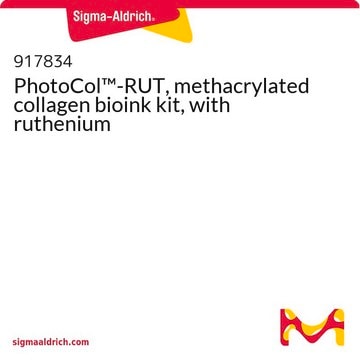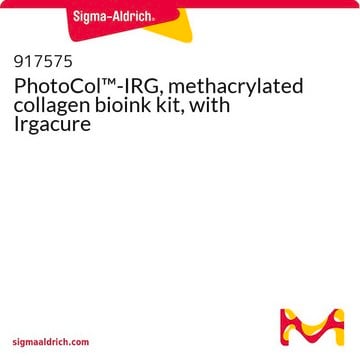おすすめの製品
詳細
Methacrylated collagen:
Degree of methacrylation ≥ 20%
Product components :
品質水準
無菌性
sterile; sterile-filtered
形状
liquid
不純物
≤10 EU/mL Endotoxin
保管温度
2-8°C
アプリケーション
PhotoCol™-LAP bioink kit consists of purified methacrylated Type I bovine collagen as the core component with other support reagents. The methacrylated Type I collagen is produced from telo-peptide intact bovine collagen where the collagen has been modified by reacting the free amines, primarily the ε-amines groups of the lysine residues as well as the a-amines groups on the N-termini. Over 20% of the total lysine residues of the collagen molecule have been methacrylated. A bottle of 20 mM acetic acid solution is provided to solubilize the lyophilized methacrylated collagen at concentrations ranging from 3 to 8 mg/ml. The neutralization solution consists of an alkaline 10X phosphate buffered saline (PBS) solution which provides physiological salts and pH in the final mixture. The photoinitiator consists of LAP to be formulated in 1X cell culture media or PBS, which allows blue light photocrosslinking of the printed structure at 405 nm. PhotoCol™-LAP provides native-like 3D collagen gels, and the final gel stiffness can be customized by changing collagen concentrations and crosslinking.
法的情報
PhotoCol is a trademark of Advanced BioMatrix, Inc.
保管分類コード
10 - Combustible liquids
適用法令
試験研究用途を考慮した関連法令を主に挙げております。化学物質以外については、一部の情報のみ提供しています。 製品を安全かつ合法的に使用することは、使用者の義務です。最新情報により修正される場合があります。WEBの反映には時間を要することがあるため、適宜SDSをご参照ください。
毒物及び劇物取締法
キットコンポーネントの情報を参照してください
PRTR
キットコンポーネントの情報を参照してください
消防法
キットコンポーネントの情報を参照してください
労働安全衛生法名称等を表示すべき危険物及び有害物
キットコンポーネントの情報を参照してください
労働安全衛生法名称等を通知すべき危険物及び有害物
キットコンポーネントの情報を参照してください
カルタヘナ法
キットコンポーネントの情報を参照してください
Jan Code
キットコンポーネントの情報を参照してください
試験成績書(COA)
製品のロット番号・バッチ番号を入力して、試験成績書(COA) を検索できます。ロット番号・バッチ番号は、製品ラベルに「Lot」または「Batch」に続いて記載されています。
A New Approach to Design Artificial 3D Microniches with Combined Chemical, Topographical, and Rheological Cues.
Stoecklin, Celine, et al.
Advanced Biosystems, 1700237-1700237 (2018)
Andrea Mazzocchi et al.
ACS biomaterials science & engineering, 5(4), 1937-1943 (2019-11-15)
Lung cancer is the leading cause of cancer-related death worldwide yet in vitro disease models have been limited to traditional 2D culture utilizing cancer cell lines. In contrast, recently developed 3D models (organoids) have been adopted by researchers to improve
Apekshya Chhetri et al.
Current protocols in chemical biology, 11(2), e65-e65 (2019-06-06)
With the increase in knowledge on the importance of the tumor microenvironment, cell culture models of cancers can be adapted to better recapitulate physiologically relevant situations. Three main microenvironmental factors influence tumor phenotype: the biochemical components that stimulate cells, the
Ian D Gaudet et al.
Biointerphases, 7(1-4), 25-25 (2012-05-17)
Type-I collagen is an attractive scaffold material for tissue engineering due to its ability to self-assemble into a fibrillar hydrogel, its innate support of tissue cells through bioactive adhesion sites, and its biodegradability. However, a lack of control of material
UV-Assisted 3D Bioprinting of Nanoreinforced Hybrid Cardiac Patch for Myocardial Tissue Engineering.
Mohammad Izadifar et al.
Tissue engineering. Part C, Methods, 24(2), 74-88 (2017-10-21)
Biofabrication of cell supportive cardiac patches that can be directly implanted on myocardial infarct is a potential solution for myocardial infarction repair. Ideally, cardiac patches should be able to mimic myocardium extracellular matrix for rapid integration with the host tissue
ライフサイエンス、有機合成、材料科学、クロマトグラフィー、分析など、あらゆる分野の研究に経験のあるメンバーがおります。.
製品に関するお問い合わせはこちら(テクニカルサービス)





